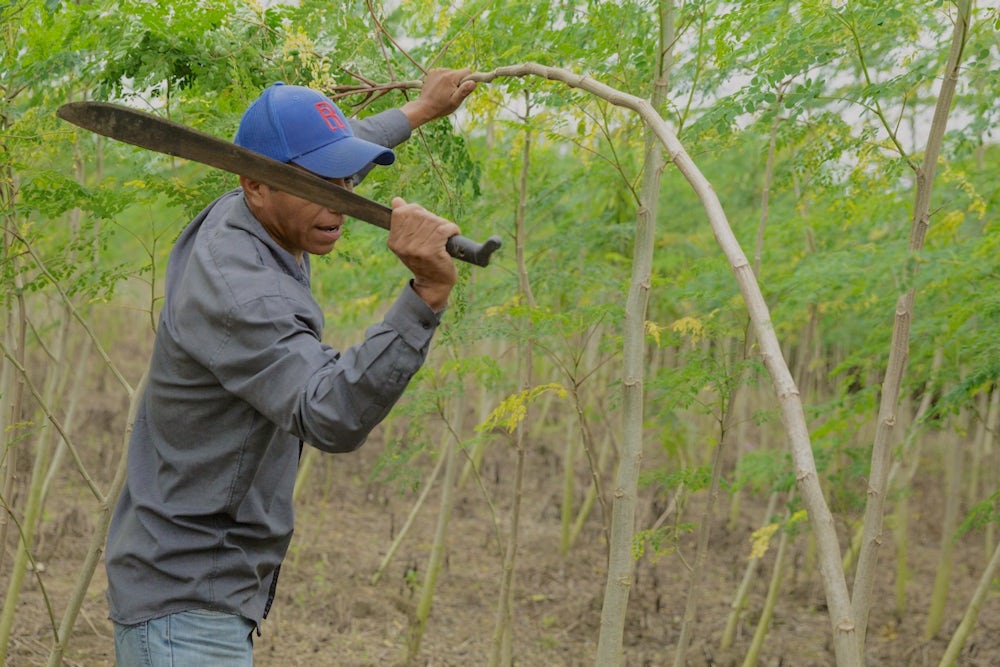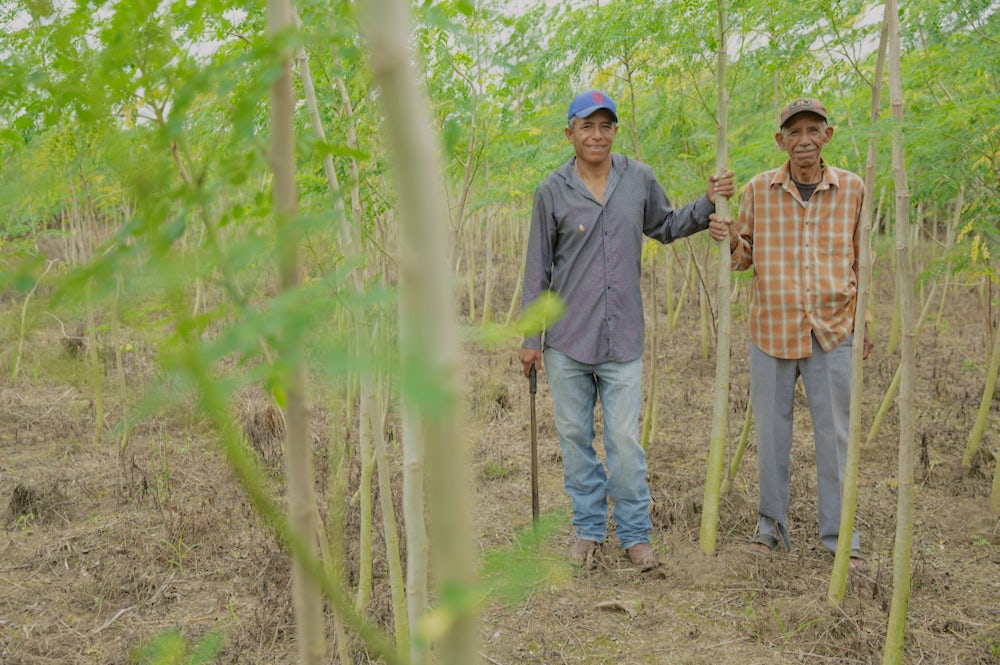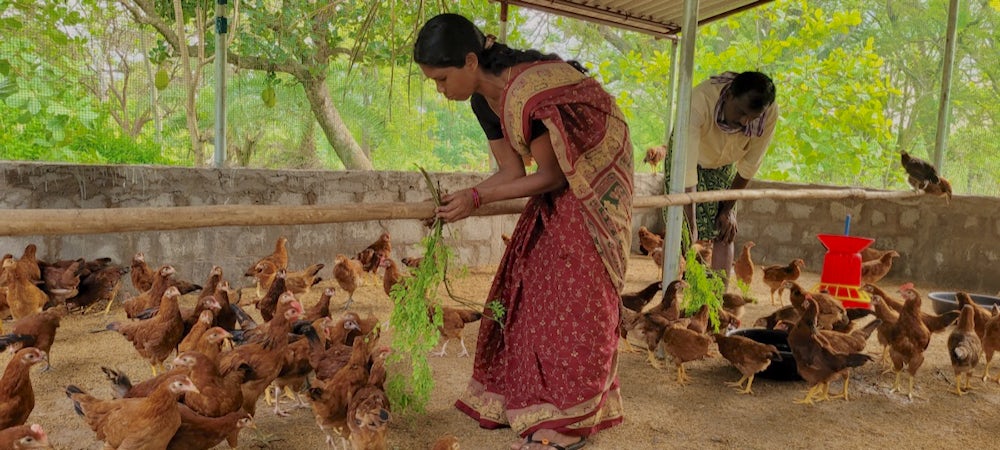Known as the “miracle tree” or “wonder tree,” moringa is a tropical plant with enormous value and incredible potential.
Read on to learn more about moringa, its uses, its benefits and how Heifer International is using the plant to help local farmers and families build more profitable and productive livelihoods.

Moringa is a deciduous tree native to the Himalayan foothills of India and Pakistan.
There are over 13 species of Moringa plants, and all of them have been used for food and medicine for hundreds of years. One of the most popular varieties is Moringa oleifera, which is now widely cultivated across tropical and subtropical areas of Asia, Africa and South America. It’s also called the drumstick tree (for the shape of its seed pods), the ben oil tree and the horseradish tree (for the taste of its roots).
Moringa has whitish-grey bark and an umbrella-shaped canopy of lush green leaves and fragrant white flowers when in bloom. The tree grows quickly — sometimes up to 20 feet, or 6 meters, in a single year — and is resistant to drought, making it one of the most dependable and economically valuable crops in places where food and water are scarce.
Across the world, Moringa is often used for food and medicine but has many industrial and agricultural uses as well.
All parts of the moringa tree are edible — from its leaves all the way down to its roots. Its leaves, pods, roots and flowers can all be cooked as vegetables but are eaten in many different ways. Leaves are cooked like spinach and can also be used for salads, or dried and ground to make a powder. Younger seed pods, when cooked, taste like asparagus, while older pods are used in curries and sauces. Oil from the seeds can be used for salad dressing or for cooking, as a substitute for olive oil, and seeds themselves can be cooked or roasted, like peanuts. Flowers can be steamed to make tea, added to sauces or made into pastes.

Moringa is used for a wide range of medicinal purposes. Moringa extracts help fight bacterial infections, address stomach disorders, and treat and manage heart disease. Moringa has also proven effective in reducing blood pressure, protecting the liver and kidneys, and treating anemia and sickle cell disease. The plant is also used to prepare medicine for livestock, aiding in the treatment of simple wounds, parasites and more, and to clean animals’ drinking water.
Moringa is also used in a variety of industrial contexts — to purify drinking water, to make paint and lubricants and even to produce biodiesel. The oil extracted from moringa seeds is used in the perfume industry and found in many other hair and skin products. Bark is used as a source of dye, and timber can be used to produce fiber for ropes and mats and pulp to make paper.
In agriculture, moringa is used as green fodder for livestock, its soft leaves and non-woody stem an important food source for cattle and other farm animals. It’s also used to help other plants grow, thanks to the phytohormones (plant hormones) found in its leaves. Spraying moringa leaf extract on the leaves of various crops such as black gram (mungo bean), peanut, soybean, sugarcane and coffee has been shown to increase plant production by as much as 35%.
Moringa has myriad benefits — for humans and for animals.
According to the United Nations Food and Agriculture Organization (FAO), moringa is one of the most nutritious plants in the world. Its leaves are rich in protein and minerals including calcium, potassium, iron and zinc. It is high in antioxidants and a vital source of vitamins A, B and C – there is more vitamin C in moringa leaves, pods and seeds than there is in four oranges combined. The plant’s nutritional properties make it an especially valuable resource for pregnant and nursing mothers and for young children suffering from malnutrition.

FAO research into this traditional crop has also found that its antibiotic, antiviral and anti-inflammatory properties make it effective in preventing and treating a long list of diseases and conditions like pneumonia, edema, asthma, arthritis and diabetes. It also has antidepressant properties and has been used to treat mental health issues including depression and anxiety.
Studies have also shown benefits for farmers who depend on livestock to make a living. The plant is able to withstand extreme temperatures, making it a valuable and increasingly popular crop as temperatures rise and drought conditions become more common. Further to this, its nutritional benefits lead to better weight gain and milk production in livestock. For vulnerable families, the plant holds the promise of building resilience and ensuring year-round feed and income.
Around the world, Heifer International helps farmers and communities use local resources, like moringa, to protect their livelihoods while caring for the environment and coping with an increasingly unpredictable climate.
What does that look like?
In India, we support the cultivation of moringa to help producers living in areas experiencing low rainfall and subsequent water shortages. We’re training farmers how to use moringa to clean drinking water for their animals and to prepare and administer medicine for their poultry, goats and pigs.

In Mexico, we’ve supplied farmers with moringa plants and taught them how to use it for fodder to improve the health of their cattle and ensure their eventual sale.
In Senegal, we’ve distributed moringa seedlings to be grown in home gardens and used as fodder for livestock, and in Bangladesh, we’ve trained farmers to harvest moringa to secure extra income and find the pathway to a more resilient future.
As we work to help more farmers earn a Sustainable Living Income through agriculture, we will continue to support them in reaping the benefits of moringa and making the most of the wonder tree’s various nutritional, healing and productive possibilities.